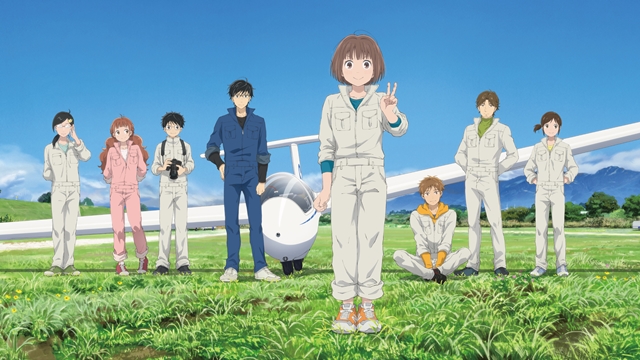Blue Thermal
February 22, 2024 · 1 comment
By Jonathan Clements.

Tamaki Tsuru ignores her mother’s complaints and applies to Aonagi University in That Fancy Tokyo, where she intends to make friends, fall in love and maybe do some studying eventually. Much more important is the selection of the right school club, because that will be the talent pool that supplies her future buddies, bedmates and probably business connections. At first, she plumps for Tennis, as after all, didn’t the last Empress meet Mr Right on a tennis court? But this lasts all of ten minutes until a stray volley causes a domino-chain of disasters, ending with damage to the Aviation Club’s prized glider. Unable to scrape up the cash to pay for it, Tamaki instead joins the Aviation Club in penance, hoping to work off her debt in the anime feature Blue Thermal.
This unlikely new position throws her in the middle between the two boys who rule the roost, the good-cop/bad-cop duo of Jun Sorachi, the club captain, and his punchy underling Daisuke Kuramochi. But it’s the kindly Jun who sees that the clumsy newcomer has real flyer potential, and who clues her up on an opportunity too good to miss. If Tamaki becomes a really good glider pilot, and if she takes top prize in the national competition, the 30,000-yen purse will clear her debts overnight. If she agrees, Jun will even throw in a boyfriend for her from the club, although this is unwelcome news to Daisuke when he’s ordered to take the role…
Clubs are a huge deal in Japanese universities, many of which can turn into social societies where students spend a couple of years recovering from the hothouse efforts of matriculating in the first place. Because a university often has direct connections with industry, a judicious choice can shunt a student firmly onto the right career path – there are universities that fast-track graduates straight into certain professions: the performing arts, politics, and even specific companies. Meanwhile, clubs often become more than mere hobbies, and more like all-consuming passions supplying much term-time socialisation, activities, friends and potential life-partners.

I will confess to having a certain bitterness about Japanese university clubs, after a run-in with the authorities in my student days, which were spent at an institution with fast-track connections to… er… air hostessing and travel agencies. [Don’t laugh: even today I can walk onto a JAL flight and get a mysterious upgrade if I’m wearing my graduation pin.] Discovering that the shogi club at Kansai Gaidai had its own suite-sized “club-room” but no members, two of my chess-playing friends and I offered to join up and restart it. We were, however, rebuffed, on the grounds that no Japanese students had volunteered to chaperone us, and the university was embarrassed that only foreigners were interested in Japanese chess. I suspect, as well, that they didn’t trust us not to burn the building down, although in the thirty years since, we’ve done okay – one of us is a US college professor, another is a diplomat in Cambodia, and I… well, they would probably still disapprove of a life in anime. But I digress…
Blue Thermal started life as a manga in Comic@Bunch, a magazine for mature readers, where it ran from 2015 to 2017 – the anime keeps close to the manga story right up to the end, which was an all-new concoction put together by the writers in consultation with the original creator. Kana Ozawa based her original pitch on her own life at college, in which she, like Tsuru, did indeed join the aviation society while studying Japanese Literature at Hosei University, eventually earning a pilot’s licence. Her manga version, however, soon drifted away from real life, not only turning her leading lady into a girl from far-off Nagasaki rather than her own native Kanagawa, but also discarding much of the original focus on a slow build towards flight. Editors insisted on putting her character in the glider early on, instead of leaving the business of taking to the air solo as a distant McGuffin, and this, in turn forced her to move away from her original plan of depicting an everygirl learning the ropes, to faster-paced narrative of a “natural” genius taking wing to the place she belongs.

Writing about the original manga’s appearance in NEO magazine, I said: “It’s not just the ridiculous expense and faffery [let’s face it, it’s a lot pricier than a tennis racquet and a few balls]. There’s also an entertaining dilemma about the nature of Tamaki’s glider fandom – is she liberated and fulfilled by her expensive hobby, or just another dilettante soullessly trying to find something that makes her look more interesting on Facebook? She puts in supreme efforts, not just in practice, but in logistics, just to win five seconds alone the sky in a search for the titular invisible updraft that will propel her to greater heights. Is this an expensive illusion of freedom, or a telling allusion to modern life?”
The movie version focusses for a while on some of the draconian rules of the aviation club – seemingly petty stipulations, like counting all the screwdrivers, that nevertheless serve a purpose in a high-risk environment. Much like the supposedly prima-donna requirements on certain rock band’s call sheets (like a demand for a saucer of all-blue M&Ms in the dressing room), it’s not merely a bit weird, but also a handy way of double-checking that a venue has read all the small print. And in a similar fashion, the onscreen drama that unfolds when Tamaki drops a £2 Philips screwdriver is designed to drill into the rookies the critical importance of careful maintenance. Otherwise, someone is going to fall out of the sky in a £20,000 coffin.

The script is packed with entertaining asides, including student bystanders annoyed that Tsuru’s glider accident hasn’t led to an on-campus punch-up, and Daisuke’s angry reaction when Tsuru assumes that the Aviation Society are a bunch of stuntmen in a wacky-raced “birdman rally.” The nature of a glider can turn some customs on their head, as Tamaki discovers when Daisuke bluntly asks her how much she weighs. She bristles like a mean-girl in a shojo manga, only to be told that if she lies about it, the counterbalances in the glider could be fatally miscalculated.
“Originally, it was supposed to be a TV series,” director Masaki Tachibana told Cho Animedia. “But then after a lot of to-ing and fro-ing, it turned into a movie, so I had to consult with Natsuko [Takahashi, co-writer] about how to trim five volumes of manga down into 90 minutes. We had to choose which chapters to drop, which to keep, and how to turn what was left into a coherent movie whole.”
He was more candid with Creators Station, a website for industry personnel, in outlining some of the pitfalls that the adaptation brought with it. “It’s a sporting story, so we can’t deviate too far from the real-world rules. But gliders don’t have engines, so the competition is a bit plain. I mean, you have to fly safely, so you can’t get the speed and thrills of, say, the Red Bull Air Race, which is a series of aerial time trials. So, I had to pay a lot of attention to the delicate balance of being true to the sport, versus fiction. It feels like I chose a storyline where both of those elements could touch down as well as possible. It doesn’t make sense to just take the fun of the story and throw away its realism, and it’s hard to choose where to draw the line.”
Tachibana alludes to a thorny series of problems deriving from the material available to him. Gliders are notoriously quiet and unpowered, which means no revving engines, nitro accelerations or afterburners. Instead, the film leans heavily on the power of silences in the air, and also on Shogo Kaida’s soaring score, which has to carry much of the weight usually ascribed to sound effects. The composer, better known for live-action but also for the Prohibition era anime series 91 Days, supplies a bunch of stirring orchestral pieces to help take up the shortfall.

“In story terms, I wanted to keep the axis that it’s Tamaki’s dedication that helps everyone. Of course, the glider is one of the main characters, but for the drama to work, the main character has to be Tamaki herself.” For that, writers Tachibana and Takahashi emphasised the big and small elements of her struggles. “Drama is born from receiving a setback and then overcoming it. But the way we define a setback depends on the person who is experiencing it. It might be ‘oh no, I dropped my candy bar’ but it would be difficult to get people to sympathise with that. So instead, with Tamaki, we have these core feelings. She grows up in a sad family environment, with a dad who denies her existence, her parents get divorced, her sister hates her. She has this broken heart from an unrequited love in high school and suddenly she gets to reinvent herself at college, a new life in a new place, and she keeps on pushing on, refusing to let the knocks and dents get to her.”
“Yasuhiro Yamako, the art director, drew really detailed backgrounds,” remembers Tachibana. “Because so much of this story takes place in the air, I needed to impart a sense of the seasons through the sky, so that’s the first thing that we talked about. Clouds are important for that. We asked him to evoke the seasons in the sky itself, such as big, fluffy cumulo nimbus in the summer, and thin clouds, like fog, in the autumn. I often draw layouts with pencils for animation, but you can’t express clouds too well with pencils. You can only draw a muffled, so-called cloud shape, and you cannot draw a realistic cloud at the layout stage.”
Tachibana cites his childhood viewing of The Goonies and The Never-Ending Story as the experiences that shaped his sense of wonder, conceding that both are live-action films, but both have a certain quality about them that he thinks animation is better at producing. “I want animation to be something that enriches the lives of its audience,” he said. “In this work, I wanted to emphasise the value of having a positive attitude even if life throws you into situations you don’t like. Now I’m a grown-up, I can appreciate that some people go to the movies to escape things they don’t like about their lives, so I guess that what I really want is that you come to see this movie, and for a while afterwards, you feel good about yourself.”
Blue Thermal is released in the UK by Anime Limited.
Christian Brunschen
July 13, 2023 3:38 pm
Will this be published in the UK, on Blu-Ray or otherwise?